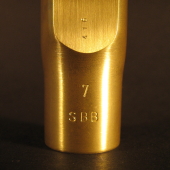What the heck is "Q-factor"?
As the title says, "... sometimes you've just got to say 'what the heck'. Every acoustical system can have these three variables that determine overall efficiency, namely:
- Capacitive Reactance (the ability to store the peak energy value within the resonant system);
- Inductive Reactance (the ability to return 'induced' acoustic energy back into the resonant system); and
- Resistance (plain ol' nasty energy-robbing, sound-stealing resistance that we all love to hate!).
Q-factor is a number between 0 and 1, where 1 would indicate a system where none of that nasty 'Resistance' is present. If you like, Q-factor determines the 'acoustical efficiency' of the overall system.
As most players are aware, there are a number of areas that determine just how good the overall setup is. As one would expect, the primary resonator (mouthpiece and reed) are of paramount importance. Equally important is the actual ligature that holds these two primary resonator components together.
If for instance a mouthpiece has been engineered to have a high Capacitive and Inductive reactance (though the use of a high IRC material), and the overall physical geometry has been engineered for a low resistance value (therefore a high Q factor), then it would follow that any external fixture such as a ligature must has some effect on the overall acoustical system - indeed it does!
The ligature can either increase or decrease the overall system efficiency by changing the Q-factor of the resonant system. The most obvious effect of utilizing a deficient or incorrect ligature design would be an overall reduction of volume, brilliance (brightness) and transient response time (slow response). This is why zagarsax supplies ligatures that are correctly engineered for the particular style and size of mouthpiece.
In summary: Q-factor can be described as a measure of the overall system (acoustic) efficiency, where an increase in resistance will have the general effect of lowering a perfect Q-factor of "1" to a lower value. Therefore, anything that can result in a lowering of Q-factor should be avoided with Zagar mouthpieces (such as fitting non-standard ligatures, tartar buildup within the mouthpiece, adhesive labels on reeds, fitting other brands of tooth patches etc).
This list is by no means complete, and if you require further information in regards to how to maintain the highest Q-factor possible (Hi Q), please feel free to Contact Us for more information. DZ
|

